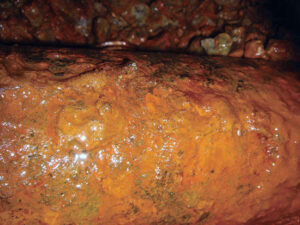 Iron bacteria are tiny, living organisms that can be found in soil, groundwater, and water. This bacteria combines iron (or manganese), and oxygen, to form “rust,” bacterial cell deposits, and a slimy substance that sticks bacteria to pipes, pumps, and other plumbing fixtures.
Iron bacteria are tiny, living organisms that can be found in soil, groundwater, and water. This bacteria combines iron (or manganese), and oxygen, to form “rust,” bacterial cell deposits, and a slimy substance that sticks bacteria to pipes, pumps, and other plumbing fixtures.
Iron bacteria have not been shown to cause disease. They can, however, create conditions that may allow for the growth of other disease-causing organisms. They can also impact the amount of water flow in pipes, and wells and cause clogging problems.
How to detect iron bacteria
- Tastes and Odors
- Swampy, oily, petroleum, cucumbers, sewage or rotten plants, or any other kind of musty.
- Color
- Stains and colored water in yellow, orange, red, or brown
- Oil-like, rainbow-colored sheen.
- Deposits of red slimy biofilm
- Sticky rusty slime, yellow, brown or grey
- “Feathery”, or filamentous growths, are common in standing water.
A laboratory can test the water to confirm it is iron bacteria.
Treatment for Iron Bacteria
There are many ways to eliminate the red slime from your basement. To make their basement look better, homeowners can do some basic maintenance and clean up the biofilm. They will need to keep the biofilm under control by cleaning it up regularly.
- Looping Dead End Plumbing: To prevent bacteria accumulation in the pipes, loop them to ensure that water flows and everything in it move continuously.
- Flushing lines: Some technicians have had success flushing pipes and wells using 140-degree Fahrenheit hot water. The heated water kills bacteria and breaks down biofilm.
- Use chlorine: Homeowners can use chlorine to remove existing biofilm and prevent iron bacteria from growing.
- French Drain Repair: You can use either the flushing process to clear the drain or dig the pipe up manually and replace it.
- Water heater: Iron bacteria can build up and cause a blockage or interference with other appliances like the water heater. After getting rid of the bacterium, your best option is to replace your water heater.
- Basement waterproofing: Choose foundation sealing or basement waterproofing to keep moisture out. This helps to keep your floors and walls dry.
- Install water filters: Water filtration systems that reduce iron and remove bacteria can be helpful.
How Iron Bacteria can wreck your basement
It is possible that your soil has high iron levels. This could lead to elevated levels of iron bacteria. The iron oxidizing bacteria can get into your home through cracks in basement walls, plumbing, or minor floods. Iron bacteria can thrive in a damp basement and will eat any iron-rich materials.
This can lead to potential problems for homeowners in different areas.
- Plumbing: Iron bacteria can build up in large colonies, clogging your pipes and causing water overflows.
- Sump Pump: If iron bacteria biofilm builds up, your sump pump may stop working.
- French Drain: The French drain can become clogged or look ugly.
- Concrete Floor and Walls: Any moisture on the basement walls or floor could lead to iron bacteria growth.
Leaky basements can carry iron bacteria into basements from the soil as well as salts and minerals. The SANI-TRED waterproofing eliminates, iron bacteria, efflorescence, mold, mildew and other threats to your basement at the source.
